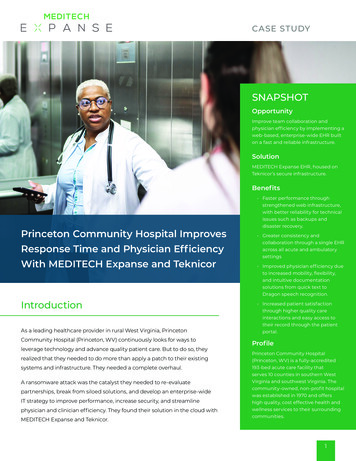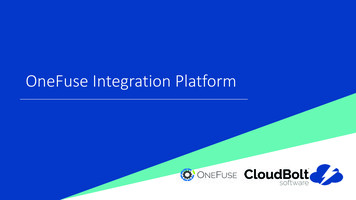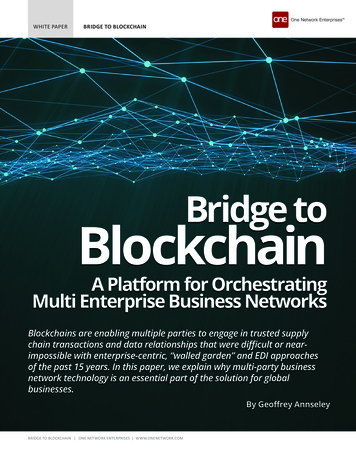
Transcription
WHITEPAPERThe Phishing Breakthrough Point
WHITEPAPER: The Phishing Breakthrough PointEVectiveness of Phishing, Training &Understanding the Human ResponseKnowBe4.Executive SummaryUtilizing security awareness training and phishing security tests can be a useful andeVective tool to reduce unintentional insider threats. However, if robust metrics arenot put in place to eVectively gauge the click rate patterns from a human landscapeperspective, phishing tests can create organizational social engineering blind spots.Meaningful phishing assessment metrics should go beyond the click rate, andunderstand human patterns relative to their job and work environment.Key Takeaways Awareness training makes a diVerence in the short and long term. IT and businessdecision makers should consider how eVective training is in the long term whenassessing the value of training services. “Low hanging fruit” phishing emails still work. It is important to understand theemployee level of awareness in terms of levels of phishing email sophistication. IT and business decision makers need to be aware of how some types of jobs, andworking hours of their employees can aVect responses to phishing emails. Data-driven phishing evaluations on who is clicking what, and when, can moreeVectively indicate patterns of phishing vulnerabilities within an organization thanthe blanket click rate of the overall organization. Clear communication with employees regarding IT updates or HR processes can playa vital role in preventing misunderstandings and blocking phishing attempts basedon generic company email themes.About this WhitepaperThis whitepaper reports the results of a 6-month experimental study testing theeVectiveness duration of the 40-minute KnowBe4 “Kevin Mitnick Security AwarenessTraining”.The scope of the experiment was on common workplace phishing emailstested among small to medium size companies. This whitepaper was sponsored by1
“The adage is true that the securitysystems have to win every time, theattacker only has to win once.”—Dustin Dykes, CISSP Founder Wirefall Consulting
State of AVairs in PhishingThe estimated annual cost of cybercrime to the world economy in 2015 was 450 billion dollars.1 That is a staggering amount in losses. The mostconcerning aspect is that 90-95% of all successful cyber-attacks begin with a phishing email.2 It’s been estimated that around 156 million emails aresent each day, 16 million make it through the filters, and 800,000 of them are not only opened, but the phishing links are clicked, and out of thosewho clicked it is estimated that around 80,000 share compromising information.3 On top of this, each quarter some 250,000 new phishing URLs areidentified.4Even though phishing can be automated in mass campaigns, the most successful campaigns are those which are tailored to an organization or person– spear phishing. However, a significant amount are successful with mass emails that appear to come from a fake or spoofed email.Getting through the mass phishing email hurdle is a breakthrough point in an individual’s or organization’s phishing awareness level. Like in thelearning of a new language, a breakthrough point5 is a turning point when the structure of a language starts to make sense and everything from thatpoint on becomes easier to learn.Similarly, in phishing, a breakthrough point is where one becomes clearly aware of the tell-tale signs, and can more easily learn and pick up on newphishing techniques. In the case of a phishing breakthrough point, once achieved, a user would consistently and systematically not click on phishinglinks over an extended period of time.Testing the Breakthrough Point in Phishing Experiment:How eVective is phishing awareness training?In the breakthrough point experiment, the eVectiveness of the KnowBe4 “KevinMitnick Security Awareness Training” was tested over the course of half a year. Usersrepresenting five diVerent small to medium size companies in critical infrastructuresectors participated in the experiment with a total of 1090 participants.The training includes a web-based interface with an interactive learning platform.Using interactive, browser-based training the participant goes through the course byclicking through items, watching videos and testing their knowledge. The averagetime to complete the training is 40 minutes.The experiment tested the most common workplace emails relating to HumanResources and IT. All participants were sent a baseline phishing email, which asksthem to change their password immediately, and if they clicked, they were taken to a‘404 Not Found’ link.Following this, participants were given a month to take the 40-minute onlinetraining, and after this, four rounds of phishing emails were sent on a monthly basis.For those who clicked on the emails sent after the baseline, they were taken to alanding page notifying them it was a phishing email and provided them with a quickrundown of things to watch out for.
2
Awareness, Click Rate Reduction and Understanding the Human Factor of thePersistent ClickersThere were four main findings of the study:(1) Achieving an organizational phishing breakthrough point was possible with the “Kevin Mitnick Security Awareness” training and wassustained for the duration of the study;(2) Moving past the click rate, patterns can be identified in organizations of those who click – in this study there were many who clicked afterworking hours;(3) Work culture and profession can play a role in phishing susceptibility;(4) The phishing emails in this experiment could have been easily identified had there been clear communication regarding HR procedures andIT issues relevant to employees.Once the overall sample of an organization hasdropped their click rate and maintained it for a steadyperiod after the training, the next challenge is notonly to maintain the low click rate, but to understandthe human aspect of those who are persistentclickers.Breakthrough Point in Phishing Experiment Click Rate16%14%14.46%12%PERCENTAGE CLICKEDSustained click rate. The results, as illustrated inthe graph, showed a sustained and consistent lowclick rate, starting with a sharp drop after the trainingand then slowly decreasing. The sustained low clickrate, months after the training was taken, indicatedthat those who fell for the phish previously did not doso again.10%8%6%4.63%4%2%1.80%2.19%0%BASELINE1st ROUND2nd ROUND3rd ROUNDAfter-hour clickers. The study examined the small percentage of those who did click even though they were trained and pieced together contextand meta-data clues in eVorts to understand the human factor of the persistent clicks. It turns out that depending on the organization, 25%-70% ofthe clickers clicked in the evenings and late at night after working hours. The combined overall percentage of those who clicked after hours was 57%.There are many factors that could be involved in these click timings, however one factor that could contribute to this is evening and graveyard shifts.While understanding this element was beyond the scope of this experiment, it was interesting to note that a significant amount of the remaining2-4% who clicked did so after traditional oflce hours (8am - 5pm).Work culture. Recognizing that each oflce or department within an organization has its own culture, the experiment controlled to see diVerencesbetween them. For example, more often than not, it is in the job description of receptionists, human resources, customer support, medicalprofessionals, and public relations employees to engage with others, build rapport, and be helpful both with members of their organization as well aswith outsiders.6
3
“You could spenda fortunepurchasingtechnology andservices, andyour networkinfrastructurecould still remainvulnerable toold-fashionedPeople in these roles tend to be targets for social engineers because of their helpfulnature towards outsiders, while those working in IT,security, and legal oflces tend tobe guarded with their information and more often than not incorporate operationalsecurity in their day-to-day lives. The study found that those whose jobs have theminteracting with outsiders were more likely to click than those who weren’t.Clear communication. The emails used in the study were simulated generic emailsrelating to Human Resources and IT issues. Some of these phishing emails could beeasily avoided through clear communication with employees regarding updates toemails, operating systems. In the human resources domain, HR processes should beclearly communicated to prevent misunderstandings and successful phishingattempts based on generic company email themes. Open channels of eVectivecommunication to clearly manage expectations on the employee side regardingtechnical IT issues and HR items can go a long way in preventing clicks on genericphishing emails about updating email passwords and HR procedures. A goodexample: “IT will never ask you for your password”.Combining Data Driven Analysis of Phishing &the Human FactorWhether it is for legal, audit, educational or security reasons, many organizationshave enlisted security awareness training companies to help them reduce the risk ofsuccessful phishing attacks. However, sometimes Boards and auditors are onlyinterested in low click rate numbers without delving deeper into the human aspect ofthose who clicked, and this can create an organizational social engineering blind spot.As it is said in cyber security circles, the defenders need to be good at preventing100% of the attacks, while the attackers only need to be successful with one attack.With hundreds of millions of phishing emails being sent each day, it is anoverwhelming endeavor on behalf of the defenders. Employees can be an eVectiveline of defense if educated properly, and when data-driven analytics help directappropriate training to the right audience.manipulation.”Achieving a phishing breakthrough point in the organization with sustained low clickrates is the first step, the next step is understanding the few that do click, andaddressing the human factor of it. If an organization is trying to reduce the risk ofphishing it needs to go beyond the click rate and understand the human element ofthe click to help contribute to a more robust counter-phishing posture.We achieved an organizational phishing breakthrough point – now what?—Kevin MitnickWhat happens after an individual or an organization has reached the phishingbreakthrough point? What next? -- Time to up the level.The breakthrough point is a launch pad for more strategic and sophisticated follow oneducation. Just as we don’t expect those who just learned to read to be able to readclassical literature; we cannot expect those who just got trained in phishingawareness to be able to respond to advanced persistent threat spear phishing emails.
Since infancy, the acquisition of human knowledge has been a gradual process –luckily it is one that can be improved and built on with education and experience.4
The next step is to do iterative adjustments to the levels of phishing. During this time it is important to have open communication channels with theinternal or external phishing service provider. For phishing email service providers, coaching should be incorporated into phishing services wherephishing coaches can help organizations figure out how best to increase their awareness in a tailored way that addresses their specific organizationalculture, sector and employees.Security Culture Supporting the Front Line Human DefenderUltimately it boils down to awareness and education. The reason why many people are familiar with the “Nigerian Prince” scam emails are because ithas been featured countless times over and over in the news,7 and a significant amount of people have encountered it either personally, throughsomeone they know; or even through jokes which are a great way to spread awareness. The bottom line is that the more people are aware of what aphishing email looks like, the better they are at avoiding it.Habits take time to form and become part of one’s daily life – the same applies to being cyber street-smart and phishing prevention. Taking a wholeorganization from zero to front line defenders against cyber criminals, industrial espionage and savvy hackers takes gradual education, and patiencein understanding the human landscape of an organization.About the AuthorDr.Lydia Kostopoulos (@LKCYBER) holds a PhD in Security Policy and is a certified social engineering pentester. She isactively engaged in the U.S. and international cyber community on several fronts fostering collaboration and raisingawareness to mitigate human vulnerability risks in cyber security. She participates in NATO’s Science for Peace Program(SPS), teaches graduate courses on intelligence and cyber statecraft, and is a member of the FBI's InfraGard Alliance.About KnowBe4KnowBe4 provides you with the world’s popular integrated Security Awareness Training and Simulated Phishing Platform.Thousands of enterprise accounts are using it with great results. Based on Kevin Mitnick’s 30 year unique first-handhacking experience, you now have a tool to better manage the urgent IT security problems of social engineering andphishing – allowing you to create your“human firewall”.This is a high quality web-based interactive training combined with frequent simulated phishing attacks, usingcase-studies, live demo videos and short comprehension tests. Kevin Mitnick Security Awareness Training specializes inmaking sure employees understand the mechanisms of spam, phishing, spear phishing, malware and social engineering,and are able to apply this knowledge in their day-to-day job. You are able to send unlimited simulated phishing attacks toyour employees year-round using our extensive library of phishing templates. For more information, please visitwww.Knowbe4.comREFERENCES:i. CSIS McAVee Report - omic-impact-cybercrime2.pdfii. TrendMicro Research - i. Get Cyber Safe - fgrphcs-2012-10-11-en.aspxiv. McAfee - c-phishing-quiz.pdfv. Neil Jones (2014). Studies in Language Testing: Multilingual Frameworks – The construction and use of multilingual proficiency frameworks. Cambridge University Pressvi. Christopher Hadnagy (2010). Social Engineering: The Art of Human Hacking. Wiley.vii. Blake Ellis. (2013). CNN Money. 5 most common financial scams - /Italian Reseller:DigiTreeVia di Romagna, 9/1 – 34134 Trieste (Italy)M. 39 366 8948545 E. sales@digitree.itW. www.digitree.it
2016 KnowBe4, Inc. All rights reserved. Other product and company names mentioned herein may be trademarks and/or registered trademarks of their respective companies.
phishing techniques. In the case of a phishing breakthrough point, once achieved, a user would consistently and systematically not click on phishing links over an extended period oftime. Testing the Breakthrough Point in Phishing Experiment: How eVective is phishing awareness training?










